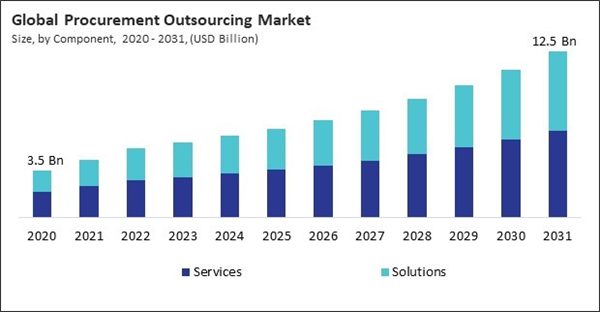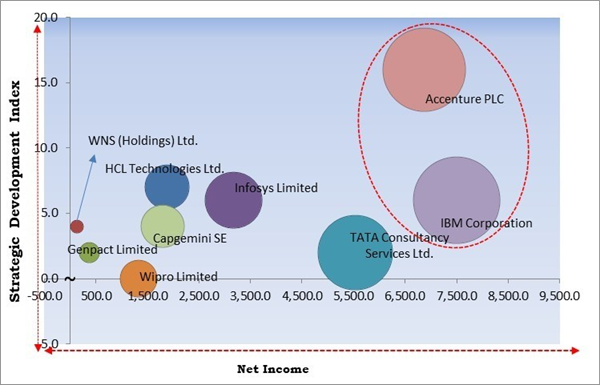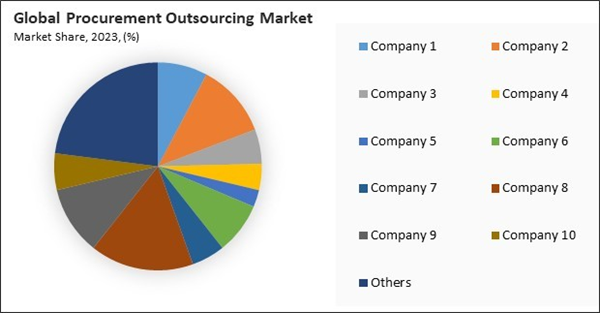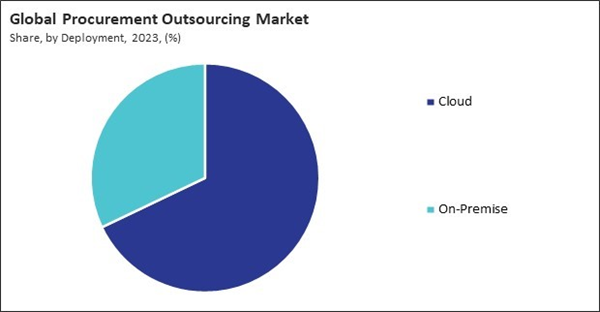The Global Procurement Outsourcing Market size is expected to reach USD12.5 billion by 2031, rising at a market growth of 10.7% CAGR during the forecast period.
The rising Banking, Financial Services, and Insurance (BFSI) sector in India significantly influences the growth of the procurement outsourcing Market. Over the past several years, the BFSI sector has shown remarkable stability and growth, underscored by an increase in bank account ownership from 53% to 78% between FY 16 and FY 21. This surge in financial inclusivity has led to a broader customer base, driving the demand for efficient procurement processes within financial institutions.
Thus, the Asia Pacific region generated 26% revenue share in the market in 2023. Countries like China, India, and Japan are emerging as key players in procurement outsourcing, driven by their expanding manufacturing capabilities and growing service sectors. Many regional businesses outsource procurement to access specialized expertise, reduce operational costs, and focus on core competencies.
The major strategies followed by the market participants are Partnerships as the key developmental strategy to keep pace with the changing demands of end users. For instance, In November, 2023, Infosys Limited partnered with Proximus, a digital communications company. The partnership aimed to modernize and consolidate the IT stack of Proximus affiliates. Additionally, In July, 2024, Genpact partnered with Reworld, a waste management company. The partnership aimed to enhance sustainability and operational efficiency in finance, sourcing, and IT functions.
Based on the Analysis presented in the KBV Cardinal matrix; IBM Corporation and Accenture PLC are the forerunners in the Procurement Outsourcing Market. In May, 2024, IBM Corporation came into partnership with SAP SE, an American technology company, to enhance generative AI capabilities and industry-specific cloud solutions. Companies such as Infosys Limited, HCL Technologies Ltd., Capgemini SE are some of the key innovators in Procurement Outsourcing Market.
Strategic sourcing emphasizes the analysis of total cost of ownership (TCO) rather than just purchase price. This approach leads to long-term savings through better supplier negotiations and reduced operational costs. By consolidating purchases through strategic sourcing, companies can leverage their buying power to negotiate better terms, discounts, and favourable contract conditions with suppliers.
Companies increasingly recognize that procurement should align with overall business strategy. SRM practices facilitate ongoing assessments of supplier performance and risk profiles, allowing organizations to anticipate and address potential issues before they escalate. Thus, rising demand for strategic sourcing and supplier relationship management is driving the growth of the market.
The leading players in the market are competing with diverse innovative offerings to remain competitive in the market. The above illustration shows the percentage of revenue shared by some of the leading companies in the market. The leading players of the market are adopting various strategies in order to cater demand coming from the different industries. The key developmental strategies in the market are Partnerships, Collaborations & Agreements.
The Procurement Outsourcing Market is highly competitive, driven by the need for cost reduction and operational efficiency. Key trends include the presence of diverse service providers, increasing integration of technologies like AI and data analytics, and a growing emphasis on sustainability in procurement processes. Globalization of supply chains adds complexity, requiring providers to navigate varied regulations. Additionally, customization and flexibility in service offerings are essential differentiators as organizations seek tailored solutions to meet their specific procurement needs.
The rising Banking, Financial Services, and Insurance (BFSI) sector in India significantly influences the growth of the procurement outsourcing Market. Over the past several years, the BFSI sector has shown remarkable stability and growth, underscored by an increase in bank account ownership from 53% to 78% between FY 16 and FY 21. This surge in financial inclusivity has led to a broader customer base, driving the demand for efficient procurement processes within financial institutions.
Thus, the Asia Pacific region generated 26% revenue share in the market in 2023. Countries like China, India, and Japan are emerging as key players in procurement outsourcing, driven by their expanding manufacturing capabilities and growing service sectors. Many regional businesses outsource procurement to access specialized expertise, reduce operational costs, and focus on core competencies.
The major strategies followed by the market participants are Partnerships as the key developmental strategy to keep pace with the changing demands of end users. For instance, In November, 2023, Infosys Limited partnered with Proximus, a digital communications company. The partnership aimed to modernize and consolidate the IT stack of Proximus affiliates. Additionally, In July, 2024, Genpact partnered with Reworld, a waste management company. The partnership aimed to enhance sustainability and operational efficiency in finance, sourcing, and IT functions.
KBV Cardinal Matrix - Market Competition Analysis
Based on the Analysis presented in the KBV Cardinal matrix; IBM Corporation and Accenture PLC are the forerunners in the Procurement Outsourcing Market. In May, 2024, IBM Corporation came into partnership with SAP SE, an American technology company, to enhance generative AI capabilities and industry-specific cloud solutions. Companies such as Infosys Limited, HCL Technologies Ltd., Capgemini SE are some of the key innovators in Procurement Outsourcing Market.
Market Growth Factors
Core competencies refer to the unique strengths and capabilities that give a company its competitive advantage in the market. These could include specialized knowledge, innovative products, or exceptional customer service. Organizations can enhance their value proposition and improve overall performance by concentrating on what they do best. Outsourcing procurement allows companies to allocate their resources more effectively. By transferring procurement functions to specialized external providers, organizations can free up internal resources - such as time, personnel, and capital - to focus on their core activities. In conclusion, increasing focus on core competencies and cost efficiency driving outsourcing decisions drives the market's growth.Strategic sourcing emphasizes the analysis of total cost of ownership (TCO) rather than just purchase price. This approach leads to long-term savings through better supplier negotiations and reduced operational costs. By consolidating purchases through strategic sourcing, companies can leverage their buying power to negotiate better terms, discounts, and favourable contract conditions with suppliers.
Companies increasingly recognize that procurement should align with overall business strategy. SRM practices facilitate ongoing assessments of supplier performance and risk profiles, allowing organizations to anticipate and address potential issues before they escalate. Thus, rising demand for strategic sourcing and supplier relationship management is driving the growth of the market.
Market Restraining Factors
Procurement processes often involve handling sensitive information, including financial details, supplier contracts, pricing strategies, and proprietary data. When outsourcing these processes, organizations risk exposing this information to external parties, which may lead to unauthorized access and data breaches. Organizations may need to invest significantly in additional security measures, such as encryption, monitoring systems, and auditing processes, to mitigate data security risks associated with outsourcing. Thus, the concerns over data security and privacy breaches in outsourced procurement processes are impeding the market's growth.The leading players in the market are competing with diverse innovative offerings to remain competitive in the market. The above illustration shows the percentage of revenue shared by some of the leading companies in the market. The leading players of the market are adopting various strategies in order to cater demand coming from the different industries. The key developmental strategies in the market are Partnerships, Collaborations & Agreements.
Driving and Restraining Factors
Drivers
- Increasing Focus on Core Competencies and Cost Efficiency Driving Outsourcing Decisions
- Rising Demand for Strategic Sourcing and Supplier Relationship Management
- Accelerated Digital Transformation Initiatives Across Industries
Restraints
- Concerns Over Data Security and Privacy Breaches in Outsourced Procurement Processes
- Inconsistent Quality of Service from Diverse Outsourcing Partners
Opportunities
- Growing Need for Enhanced Data Management and Procurement Analytics Capabilities
- Increased Regulatory Compliance and Governance in Procurement Practices
Challenges
- Integration Difficulties with Existing Internal Systems and Processes
- Challenges in Quantifying Return on Investment (ROI) from Outsourcing
Organization Size Outlook
On the basis of organization size, the market is segmented into small and medium-sized enterprises (SMEs) and large enterprises. The large enterprises segment recorded 58% revenue share in the market in 2023. This segment includes multinational corporations and large-scale businesses with substantial procurement needs and complex supply chains. The prominence of large enterprises in the market can be attributed to several factors.Deployment Outlook
Based on deployment the market is bifurcated into cloud and on-premise. The cloud segment acquired 68% revenue share in the market. Cloud-based solutions are highly scalable, allowing organizations to easily adjust resources based on their needs. They often reduce upfront costs associated with hardware and maintenance, as expenses are typically spread out as subscription fees. Cloud solutions can be accessed from anywhere, offering flexibility and remote access which is crucial for global operations.Industry Vertical Outlook
By industry vertical, the market is divided into BFSI, healthcare, and IT & telecommunication. The IT & telecommunication segment procured 31% revenue share in the market in 2023. This segment encompasses various organizations, including software companies, telecommunications providers, and IT service firms, all with unique procurement needs driven by rapid technological advancements and changing market dynamics. The growth of the IT & telecommunications sector is closely tied to the increasing demand for digital transformation and innovation.Component Outlook
Based on component, the market is divided into solutions and services. In 2023, the solutions segment garnered 46% revenue share in the market. This segment includes software and platforms designed to streamline and optimize procurement processes. Solutions often encompass a range of functionalities such as supplier management, spend analysis, e-sourcing, contract management, and procure-to-pay (P2P) automation. The prominence of the solution segment can be attributed to several factors.By Regional Analysis
Region-wise, the market is analyzed across North America, Europe, Asia Pacific, and LAMEA. The North America region witnessed 38% revenue share in the market in 2023. This dominance can be attributed to several key factors inherent to the region. North America, particularly the United States, is home to many multinational corporations with extensive and complex procurement needs. These organizations are increasingly recognizing the strategic advantages of outsourcing procurement functions to specialized providers, which has driven significant growth in the market.Market Competition and Attributes
The Procurement Outsourcing Market is highly competitive, driven by the need for cost reduction and operational efficiency. Key trends include the presence of diverse service providers, increasing integration of technologies like AI and data analytics, and a growing emphasis on sustainability in procurement processes. Globalization of supply chains adds complexity, requiring providers to navigate varied regulations. Additionally, customization and flexibility in service offerings are essential differentiators as organizations seek tailored solutions to meet their specific procurement needs.
Recent Strategies Deployed in the Market
- 2024-Feb: Accenture PLC took over Insight Sourcing, a provider of strategic sourcing and procurement services. The acquisition enhances Accenture's sourcing and procurement services for private equity and various industries.
- 2024-Jan: Accenture PLC announced the acquisition of Impendi, a sourcing and procurement services provider with a focus on private equity clients. This acquisition strengthens Accenture's offerings in advisory and technology, enabling faster value realization for private equity investments and expanding its talent and services in the industry.
- 2023-Nov: Infosys Limited partnered with Proximus,a digital communications company. The partnership aimed to modernize and consolidate the IT stack of Proximus affiliates.
- 2023-Oct: Infosys Limited announced a partnership with Google cloud, a cloud comuting company, to integrate generative AI into enterprises using Infosys Topaz and Google Cloud's AI solutions. The partnership would drive AI-powered business transformation and enhance customer experiences across multiple sectors.
- 2023-Aug: Tata Consultancy Services (TCS) partnered with the Government of India to transform the Government e-Marketplace (GeM) into a modern, scalable procurement platform. The new system would enhance transparency, efficiency, and inclusivity, leveraging advanced technologies like AI/ML and data analytics to improve operations and support diverse vendor participation.
List of Key Companies Profiled
- Infosys Limited
- TATA Consultancy Services Ltd.
- HCL Technologies Ltd.
- WNS (Holdings) Ltd.
- NB Ventures, Inc. (Global eProcure)
- Wipro Limited
- IBM Corporation
- Accenture PLC
- Genpact Limited
- Capgemini SE
Market Report Segmentation
By Component
- Services
- Solutions
By Deployment
- Cloud
- On-Premise
By Industry Vertical
- BFSI
- IT & Telecommunication
- Healthcare
By Organization Size
- Large Enterprises
- Small and Medium-sized Enterprises (SMEs)
By Geography
- North America
- US
- Canada
- Mexico
- Rest of North America
- Europe
- Germany
- UK
- France
- Russia
- Spain
- Italy
- Rest of Europe
- Asia Pacific
- China
- Japan
- India
- South Korea
- Australia
- Malaysia
- Rest of Asia Pacific
- LAMEA
- Brazil
- Argentina
- UAE
- Saudi Arabia
- South Africa
- Nigeria
- Rest of LAMEA
Table of Contents
Chapter 1. Market Scope & Methodology
Chapter 2. Market at a Glance
Chapter 3. Market Overview
Chapter 4. Competition Analysis - Global
Chapter 5. Global Procurement Outsourcing Market by Component
Chapter 6. Global Procurement Outsourcing Market by Deployment
Chapter 7. Global Procurement Outsourcing Market by Industry Vertical
Chapter 8. Global Procurement Outsourcing Market by Organization Size
Chapter 9. Global Procurement Outsourcing Market by Region
Chapter 10. Company Profiles
Companies Mentioned
Some of the key companies in the Procurement Outsourcing Market include:- Infosys Limited
- TATA Consultancy Services Ltd.
- HCL Technologies Ltd.
- WNS (Holdings) Ltd.
- NB Ventures, Inc. (Global eProcure)
- Wipro Limited
- IBM Corporation
- Accenture PLC
- Genpact Limited
- Capgemini SE
Methodology

LOADING...













